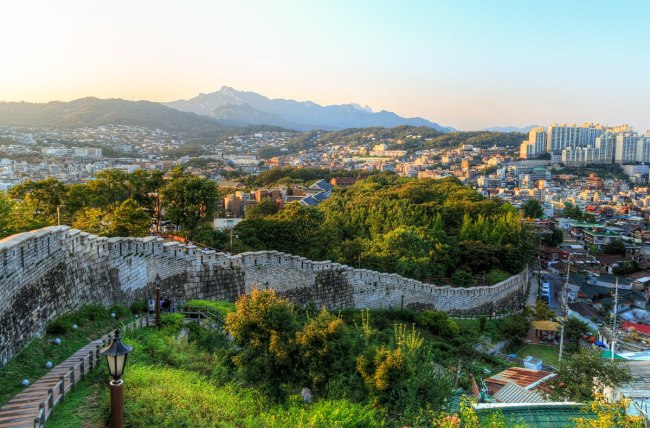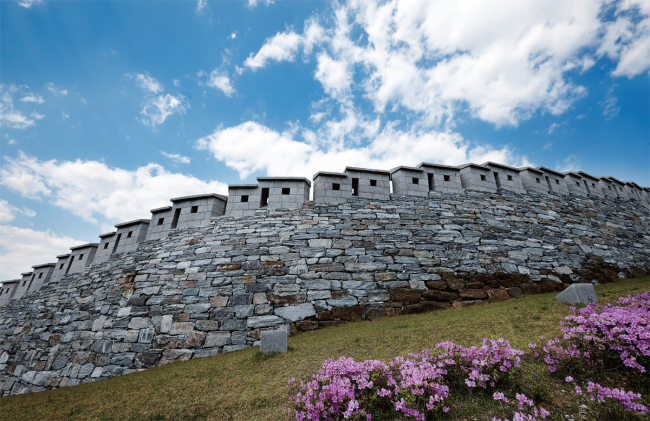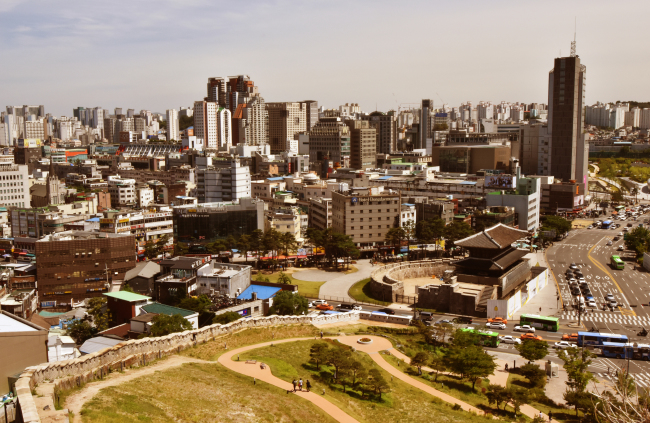Taking in Seoul’s hidden gems along Fortress Wall
“The jaunt offers a scenery of a spectacular panorama. Especially in a good season, when descending on a Namsan slope canopied by pine trees and flowers, one can savor every nook and cranny that unfolds like a painting.”
By Joel LeePublished : Sept. 27, 2018 - 17:12
Emile Bourdartet, a French engineer who came to Korea in 1900 to help construct railways and mines, said of Seoul Fortress Wall, “It is possible to walk the whole length of this wall in a single day. It is a very interesting walkway for those skilled at sauntering and hiking.”
He was writing about his experiences of Korea in “The Last Breath of the Korean Empire,” which became France’s most widely read book about the land of the morning calm after it was published in 1904.
“The jaunt offers a scenery of a spectacular panorama. Especially in a good season, when descending on a Namsan slope canopied by pine trees and flowers, one can savor every nook and cranny that unfolds like a painting.”
He was writing about his experiences of Korea in “The Last Breath of the Korean Empire,” which became France’s most widely read book about the land of the morning calm after it was published in 1904.
“The jaunt offers a scenery of a spectacular panorama. Especially in a good season, when descending on a Namsan slope canopied by pine trees and flowers, one can savor every nook and cranny that unfolds like a painting.”

Nearly 120 years later, visitors to Seoul Fortress Wall can revel in a much-changed but equally gratifying view, as it has become a beloved walking trail.
The construction of the wall was completed in 1396 by King Taejo (1335-1408), the founder of the Joseon Kingdom (1392-1897). It was a defensive bulwark for Hanyang, the primordial seat of the kingdom, which evolved into Seoul. Much of its 19-kilometer length was destroyed during the 1910-45 Japanese colonial era and 1950-53 Korean War. But through numerous renovations, more than 70 percent of the structure has been restored to its former stature.
During the Joseon era, the bastion was surrounded by eight gates, all built from 1396-98, which provided entry into the city. Six of the gates can still be seen. The entire rampart is divided into four official sections for hiking.
I started my stroll on a pleasant Sunday afternoon at the north end of the second section of the wall at Hyehwamun -- one of the eight gates, also known as the Northeast Gate -- near Hanseong University Station. Hyehwamun, meaning the Gate of Sharing Wisdom, was burned to the ground during the Japanese colonial period to make way for a streetcar line, but was rebuilt in 1992, slightly north of its original site.
From there I walked to Heunginjimun, the latter meaning the Gate of Rising Benevolence, more commonly known as Dongdaemun. I recommend starting on this section, covering 2.1 kilometers, because it has a gentle slope and is easy to walk along. It is also full of charming spots.

Hyehwamun is in the vicinity of Daehangno, a colorful neighborhood full of restaurants, bars, shops and theaters that cater to youngsters and students from nearby universities. Daehangno is where college students and youths have gathered for leisure and entertainment since the 1970s. After Marronnier Park was created in the space formerly occupied by Seoul National University colleges, many cultural and arts organizations moved in for plays, movies, concerts and musicals starting from the mid-1980s.
It is still a popular haunt for youngsters, hipsters and couples, with buskers performing throughout the day.
Start by crossing the street from Hyehwamun onto a strip of woodland that stretches down to Heunginjimun.
As Korea’s autumn is known for its deep-blue sky, the route is an ideal getaway from the hustle and bustle of the city. Also because of the diverse activities possible, the passage is one of my favorite escapes in the indefatigably dynamic Seoul.
The track can be followed both along the inside and outside of the wall, but I recommend the outer one for a more scenic view. There are also several small hidden gates along the fort through which you can move between the inner and outer sides.
The nighttime is special, as the fortification lights up and forms an entrancing spectacle.

The path from Hyehwamun to the middle of Naksan Park -- the backdrop of several Korean television dramas -- is the most beautiful part of the trail, people say, with the fortress wall blending graciously into the adjacent bushes and neighborhoods in a sinuous curve.
Naksan Park itself is a hidden gem. It has several squares for rest and observation of the neighborhoods below, as well as halcyon footpaths replete with lush greenery.
Those who want a break from the exercise can stop by Ihwa Mural Village, a residential area filled with murals and art installations. Florid paintings adorn steps, walls and building facades in creviced alleys on steep slopes.
The sweetest part of the village experience would be sipping a coffee or beer on a cafe terrace, overlooking downtown Seoul, which lies to the west. The view affords a slice of Seoul’s eclectic, kaleidoscopic cityscape.
Following that, continue promenading southward toward Heunginjimun along the wall. Near the end, you can see the Dongdaemun shopping district and its malls, Dongdaemun Design Plaza and Cheonggye Stream. If you are hungry after some two to three hours of peregrination, I recommend having a hot pot of a whole chicken for dinner at one of the many restaurants west of Heunginjimun. You can also get grilled fish, seafood pancake and other homey dishes.
And if all of this is not enough, you can go shopping at Doota, Hyundai City Outlet, Migliore, APM Shopping Mall or Good Morning City, among other malls. They open late into the night.
By Joel Lee (joel@heraldcorp.com)


















![[Today’s K-pop] Treasure to publish magazine for debut anniversary](http://res.heraldm.com/phpwas/restmb_idxmake.php?idx=642&simg=/content/image/2024/07/26/20240726050551_0.jpg&u=)